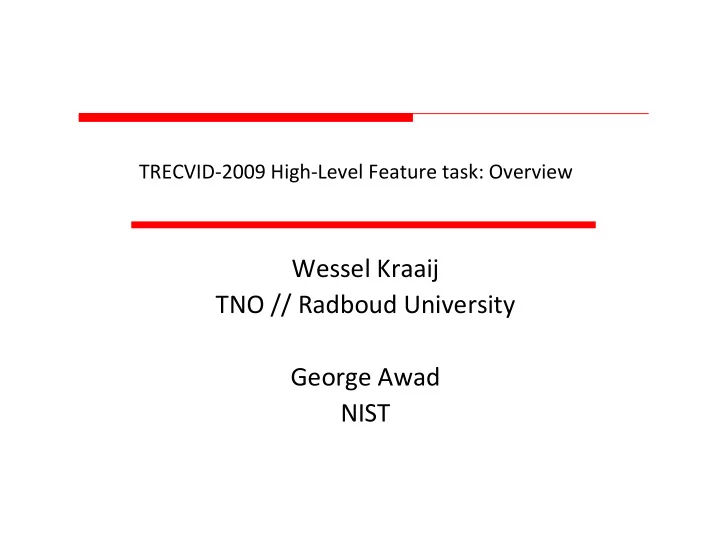

TRECVID-2009 High-Level Feature task: Overview Wessel Kraaij Wessel Kraaij TNO // Radboud University George Awad NIST
Outline � Task summary � Evaluation details � Inferred Average precision � Participants � Evaluation results � Pool analysis � Pool analysis � Results per category � Results per feature � Significance tests per category � Global Observations � Issues
High-level feature task (1) � Goal: Build benchmark collection for visual concept detection methods � Secondary goals: � encourage generic (scalable) methods for detector development � semantic annotation is important for search/browsing � Participants submitted runs for 10 features from those tested � Participants submitted runs for 10 features from those tested in 2008 and 10 new features for 2009. � Common annotation for new features coordinated by LIG/LIF � TRECVID 2009 video data � Netherlands Institute for Sound and Vision (~ 380 hours of news magazine, science news, news reports, documentaries, educational programming and archival video in MPEG-1). � ~100 hours for development (50 hrs TV2007 dev. + 50 hrs TV2007 test) � 280 hours for test (100 hrs TV2008 test + new 180 hrs TV2009 test)
High-level feature task (2) � NIST evaluated 20 features using a 50% random sample of the submission pools (Inferred AP) � Four training types were allowed � A : � Systems trained on only common TRECVID development collection data OR � (formerly B) systems trained on only common development collection data (formerly B) systems trained on only common development collection data but not on (just) common annotation of it. � C : System is not of type A. � a : same as A but no training data specific to any sound and vision data has been used (TV6 and before). � c : same as C but no training data specific to any sound and vision data has been used. � Training category B,b has been dropped allowing systems to focus on: � If training data was from the common development & annotation. � If training data belongs to S&V data.
Run type determined by sources of training data A C a c TV3-6 (Broadcast news) (Broadcast news) TV7,8,9 (S&V) Other training data
TV2007 vs TV2008 vs TV2009 datasets TV2009 = TV2007 TV2008 TV2008 + New Dataset length length ~100 ~100 ~200 ~200 More diversity More diversity ~380 ~380 from the long (hours) tail Shots 18,142 35,766 93,902 Unique program 47 77 184 titles
TV2009 10 new features selection � Participants suggested features that include: � Parts of natural scenes. � Child. � Sports. � Non-speech audio component. � People and objects in action. � People and objects in action. � Frequency in consumer video. � NIST basic selection criteria: � Features has to be moderately frequent � Has clear definition � Be of use in searching � No overlap with previously used topics/features
20 features evaluated 1 Classroom* � 11 Person_riding_bicycle � 2 Chair � 12 Telephone* � 3 Infant � 13 Person_eating � 4 Traffic_intersection � 14 Demonstration_Or_Protest* � 5 Doorway � 15 Hand* � 6 Airplane_flying* � 16 People_dancing � 7 Person_playing_musical_instrument 7 Person_playing_musical_instrument � 17 Nighttime* � 17 Nighttime* � � 8 Bus* � 18 Boat_ship* � 9 Person_playing_soccer � 19 Female_human_face_closeup � � 10 Cityscape* � 20 Singing* -Features were selected to be better suited to sound and vision data - The 10 marked with “*” are a subset of those tested in 2008
Evaluation � Each feature assumed to be binary: absent or present for each master reference shot � Task: Find shots that contain a certain feature, rank them according to confidence measure, submit the top 2000 � NIST pooled and judged top results from all submissions � NIST pooled and judged top results from all submissions � Evaluated performance effectiveness by calculating the inferred average precision of each feature result � Compared runs in terms of mean inferred average precision across the 20 feature results.
Inferred average precision (infAP) � Developed* by Emine Yilmaz and Javed A. Aslam at Northeastern University � Estimates average precision surprisingly well using a surprisingly small sample of judgments from the usual submission pools � This means that more features can be judged with same � This means that more features can be judged with same annotation effort � Cost is less detail and more variability for each feature result in a run � Experiments on TRECVID 2005, 2006, 2007 & 2008 feature submissions confirmed quality of the estimate in terms of actual scores and system ranking �������������������������������������� ������������������������������������������������������������������� �������������������������� �!"#"$�������������!���������%%&�
2009: Inferred average precision (infAP) � Submissions for each of 20 features were pooled down to about 100 items (so that each feature pool contained ~ 6500 - 7000 shots) (2008: 130 items, 6777 shots) � varying pool depth per feature � A 50% random sample of each pool was then judged: � A 50% random sample of each pool was then judged: � 68,270 total judgments (TV8: 67,774) � 7036 total hits � Judgment process: one assessor per feature, watched complete shot while listening to the audio. � infAP was calculated using the judged and unjudged pool by trec_eval
2009 : 42/70 Finishers ����������������������������������������������������������� ������ �� ����������������������������� ������������� ������������������������������ �������!��"��#$������������������������ ���������"���������������� ������������� ���������������� ���������� �� ����� ��%����������������������� �� ������ �� ��������������������������������������� ������� �� ������ �� �& ������������� �� ������ �� �� �������������! ���������� �� %�"�'������#�������������� ������������� ������������������!���" ������������� (�#�%�%��� %#%"���������&! (�#�%�%��� %#%"���������&! ������������� ������������� �#$�� ������ $%��&% �� ��������� ����%�����&������������������"����!����� �� ������ �� %��#�� ��)% �� ������ �� ����������� �!��������������%*�+,$�#+%�+��� ���������� �� '�(����������)��*������+���������������������������� �� ������ �� $�-��������� .%����!���/&�� ��(����-�� �� ��������� $�%�0����������1��& ���&����*�� �� ������ �� ��������������"��-&�� �� ��������� ���������������!���� �! ������������� �������*�������������������������!�,����� �� ��������� ������������������!��#%� �� ������ �� -,.�$������������������������������'�(��������� �/������$��00 ,��������%�����&������%����!����� ������������� 23��� 4%%%� �� ������ �� 5����������������������������������)) �� ��������� ���'�����(�����)����*������+�����������������������������������*���'�����������*����,-.����������%%/ 00 '�����(�����)��(������(���
Recommend
More recommend